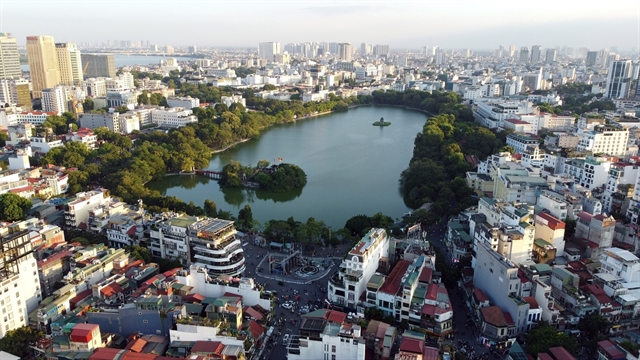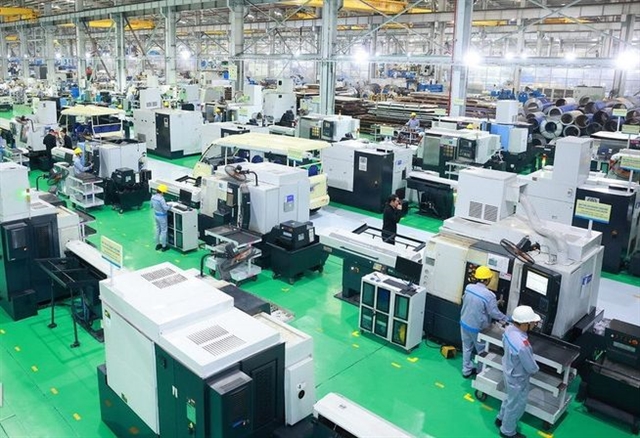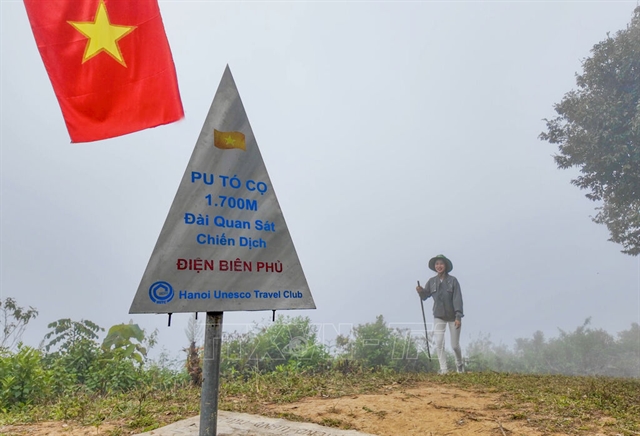 Society
Society

A young engineer in Nghệ An Province has been honoured for several scientific and technological initiatives that contribute to environmental protection.

|
| Hồ Xuân Vinh (right) explains the techniques to a worker in Hồ Hoàn Cầu Mechanical Factory. — VNA/VNS Photo Văn Tý |
NGHỆ AN — A young engineer in Nghệ An Province has been honoured for several scientific and technological initiatives that contribute to environmental protection.
After completing a master’s programme and working at Hà Nội University of Technology, in 2012, Hồ Xuân Vinh, 35, returned to his hometown Quỳnh Lưu District, Nghệ An, to follow in his father's footsteps working at Hồ Hoàn Cầu Mechanical Factory.
Inheriting his father's passion for manufacturing machinery and mechanics, Vinh has continuously made inventions bringing high economic efficiency to the factory.
The first and most successful product of Vinh was a machine producing bricks without the need for burning in a kiln.
Realising that such materials were increasingly needed on the market but machines to make them were in short supply and expensive, he set about addressing the problem.
After many failures, in 2014, he successfully developed a mechanical brick pressing machine.
Not stopping there, Vinh continuously improved and developed the machine into a 2-way hydraulic pressing brick machine with a fully automatic function with a capacity of 15,000 bricks per hour.
The product won first prize in the Nghệ An Science and Technology Innovation Contest in 2017 and received positive feedback from customers.
In 2017, Vinh was selected by the Ministry of Science and Technology, the World Bank and the Việt Nam Climate Innovation Centre as the chairman and sponsor of an innovative anti-climate change project for reducing agricultural clay use, emissions, and fuel consumption, all through the brick production.
The project surpassed the target in one year and supplied the market with 520 sets of machines, producing 728 million bricks.
Vinh said: "In Việt Nam, the situation of copying and pirating machinery was prevalent. The companies’ products were rapidly copied after being launched on the market, but it was difficult to sue because it costs time and money,” said Vinh.
“Therefore, in addition to implementing strategies on aftersales and customer care services, we must constantly improve our products to always to be the first."
He has successfully developed several well-received products by the market, such as the Terrazzo brick pressing machine, automatic steel belt breaking machine, and fresh concrete mixers.
From the two initial products, Hồ Hoàn Cầu Mechanical Factory now has 16 product categories.
The production lines of Hồ Hoàn Cầu materials are now present in 63 provinces and cities nationwide and exported to many countries such as Laos, Cambodia, Thailand, Angola, Ivory Coast and Cuba.
"In my hometown of Quỳnh Văn Commune, there are more than 250 sets of brick machines provided by my factory, which helped form a sustainable brick village, creating livelihoods for thousands of local workers,” said Vinh.
“This is also the only and first commune in the country with a brick village, and it is a model of the 567 Programme of the Ministry of Construction on the development of the unburnt bricks."
Green desire
Following the machine's success, Vinh recently invented the fibre-processing machine for banana waste.
Vinh said: "The machine can split and separate the fibres from the bananas. It turns the banana sheath into a large amount of fibre as raw materials for many industries in Việt Nam such as in the fashion industry, packaging, and paper.”
“In addition, I researched the technology of pressing dry residue and water, so the water would ferment to become nutrient-rich potassium water, which is an excellent organic fertiliser for plants, and the residue can be used as disposable bowls, plates, trays, or composted as organic fertiliser for banana gardens. This technology helped farmers gain a more stable income.
In 2021, Vinh boldly established ABACA Việt Nam Company Limited with the ambition to lead the market and make new technology lines and models.
Last year, the Central Youth Union appreciated this innovative model as one of three innovative models introduced in the Việt Nam-Laos-Cambodia International Youth Forum. It was certified as a typical innovation model by the North Central Youth Union.
The banana fibre development project won first prize in the Innovation Startup Contest in 2021; first prize in the National Agriculture Start-up and Innovation Competition co-organised by the Việt Nam Academy of Agriculture and the Ministry of Science and Technology; as well as second and third prizes at the VIFOTEC Contest of Nghệ An Province in 2021.
In addition, the project won third prize at the National Start-up Project Development Programme in 2021.
For his inventions and useful solutions, Vinh received the Lương Định Của Award of the year in 2021 and many other certificates of merit from several departments and agencies across the country.
"For a scientific and technological invention, the first thing is to evaluate its feasibility and applicability in life,” Vinh said.
“To make an invention, the most important conditions are capital and technology. You must understand deeply about the technique and have long-term capital investment for it.
“Each invention has to go through many trials that require huge perseverance, so I never thought about overnight success." — VNS




